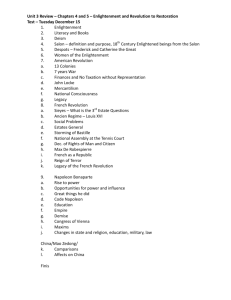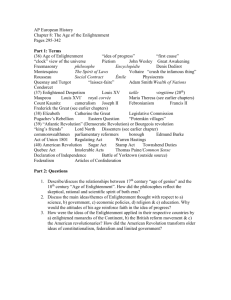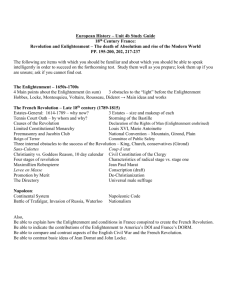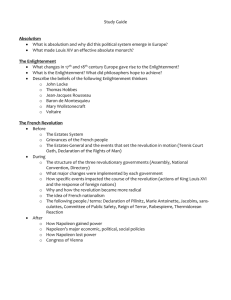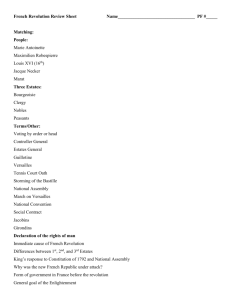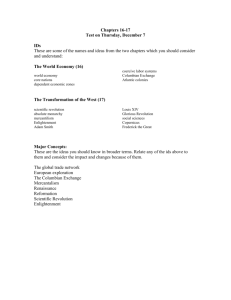18th Century - 59-105-201-f10
advertisement
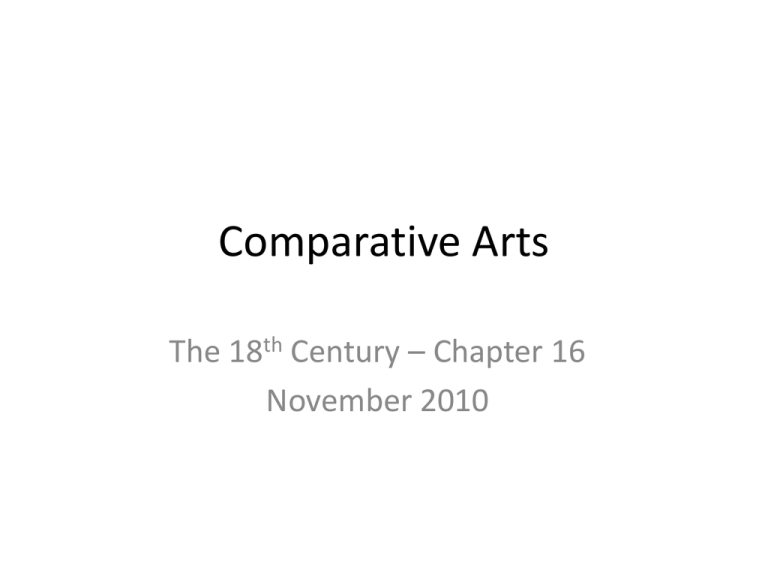
Comparative Arts The 18th Century – Chapter 16 November 2010 The 18th Century • Between about 1700 and 1800, the world experienced massive change in the realms of politics, intellectual development, science, industry and society. • The 18th century has been called the ‘Age of Reason’ because of the emergence of the intellectual revolution in Europe we have come to call ‘the Enlightenment’ • During the Enlightenment, reason (as opposed to religion) was advocated as the primary source for legitimacy and authority – Also, ideas of freedom and democracy emerged during the Enlightenment • The ‘Sacred Circle’ disintegrates – The Sacred Circle is the interdependent relationship between the hereditary aristocracy, the leaders of the church and the text of the Bible. This interrelationship manifests itself as kings invoking the doctrine "Divine Right of Kings" to rule. Thus church sanctioned the rule of the king and the king defended the church in return. • Two great movements of the 18th century: – The Enlightenment – Neoclassicism, which looked back to classical antiquity Where was the Enlightenment? • The Enlightenment did not emerge in one particular place: it developed simultaneously in France, Germany, and Great Britain, as well as the Netherlands, Italy, Spain, Portugal and the American colonies • The Enlightenment was not a single movement or school of thought – it was more a set of values: critical questioning of traditional institutions, customs and morals, and a strong belief in rationality and science • Authors of various pivotal documents were motivated by Enlightenment principles: – – – – The American Declaration of Independence The United States Bill of Rights The French Declaration of the Rights of Man and of the Citizen Etc So what was going on in the world in the 18th century? • • • • • Colonialism The Industrial Revolution Decadent monarchies crumbling Rococo The scientific revolution (Isaac Newton, Denis Diderot, Carolus Linnaeus) • Revolutions springing up 18th century Colonialism Colonialism refers to the establishment and maintenance of colonies in one territory by people from another territory. The colony’s social structure, government and economics are changed by colonists. The relationship between colonizers and indigenous population is unequal and often exploitative. Colonial-era racial philosophy • There was still a very unsophisticated understanding of intelligence, brain function, cultural difference • The Victorian era was particularly obsessed with categorizations, hierarchies, taxonomies • Scientists attempted to identity and classify all plants and animals – as well as humans • There was a deep ignorance about race, which was assumed to account for human difference – we now know that race is superficial and humans are different due to a variety of factors: access to resources, education, culture, etc. Identifying criminals by facial features! Colonialism and the city • A disregard for indigenous knowledge and land claims (e.g. Afghan cameleers and explorers in Australia not valued as much as white explorers) • Colonial cities can generally be characterized by distinct quarters for racial groups based on assumptions about each race • Various colonial philosophies expressed through architecture and urbanism: – – – – – Imperialism Modern social values about hygiene Ideas about eugenics and racial purity ‘Ethnic’ revivalism religion • Colonial philosophies about segregating people based on race evolved into a variety of urban forms: segregated cities based on race (Chinatowns, etc), apartheid in South Africa, segregation in the American south, the native America reservation system and other reservation systems for indigenous people) Still existing colonial era districts based on race: Indian district, Chinatown, Malay kampung (village) 12 13 Grand colonial district, Kuala Lumpur Victoria Memorial Hall, Kolkata – classic British Raj style: a blend of neo-classical and Orientalist fantasy Mughal in the former capital of British India -dedicated to Victoria, Queen of the United Kingdom and Empress of India -this style promoted the British sense of ‘rightful self-glorification’ -built on a massive scale to promote a notion of unassailable and invincible British Empire British Raj architecture, Kuala Lumpur, Malaysia -British Raj buildings adopted ‘orientalist’ elements while using British structural engineering standards of the 1800s (iron, reinforced steel, poured concrete, pre-cast elements) British Raj architecture featured bulbous domes, domed kiosks, clusters of miniature domes, towers or minarets, arcading, Industrial Revolution Age of Invention: steam engine, telegraph, telephone, phonograph, diesel engine, airplane… All sectors of life were transformed Reinforced concrete, Portland cement and iron used to create massive structures (bridges, train stations, factories), replaced wood and limestone in building Growing social ills: low wages, long working hours, child labor, unhealthy work conditions, widespread misery, over-work, disease, no child labor laws Craftspeople, especially lace makers and weavers, found themselves out of work due to factories. A group known as the Luddites began destroying factories and the machinery that had taken their jobs. The British government took drastic measures to protect industry, using the army to break up rioters. Those caught were hanged or transported. Responses to the Industrial Revolution: Luddites at work destroying machines and factories William Morris, a British social reformer, artist and architect (1834-1896) believed that traditions of craftsmanship had been lost during the Industrial Revolution. He pursued the revival of hand craftsmanship to enable workers to achieve satisfaction and pleasure in their work Marxism • The Industrial Revolution concentrated labor into mills, factories, and mines • Socialism and Marxism emerged as a reaction to the Industrial Revolution • Karl Marx viewed that industrialization polarized society – required a majority of the population laboring for the benefit of the bourgeoisie, perpetuating feudal relationships • The goal of Marxists was to bridge the gap between rich and poor The growth of modern industry led to massive urbanization as new opportunities were created in cities. The population grew and new areas were settled in the colonies. Cities in the UK grew overcrowded and unhealthy. In 1800, only 3% of the world’s population lived in cities. 50% of the world now lives in cities. In 1717, Manchester had 10,000 people. By 1911, the population was 2.3 million. The population of England and Wales went from a steady 6 million in 1740 to 30.5 million in 1900. Britain’s population doubled every 50 years during the Industrial Revolution. Cities were incredibly unhealthy due to high densities, a lack of infrastructure (e.g. sewage) for the majority of people, coal burning produced a constant smog that dimmed the sun. Tuberculosis (and to a lesser extent, cholera) was the major killer in cities. By the late 19th century, 70-90% of the urban populations of Europe and North America were infected with tuberculosis. 40% of working class deaths in cities were from TB. Rococo in France • The Rococo style of art was seen by many to be decadent and self-serving • It was commissioned by the same powerful aristocratic families who were seen as suppressors of the people’s freedom • The Rococo art of the aristocracy was precisely what the Enlightenment came to define itself against Jean-Antoine Watteau, Pilgrimage to Cythera, 1717 The Rococo style is characterized by lightness both of content and of color; romantic pastimes are portrayed in an atmosphere of aristocratic hedonism. What do these images tell you about society in the 18th century? These are typical European paintings from the 18th century. What is going on in them? Why do you think they were painted? Enlightenment thinkers • Enlightenment thinkers: http://www.youtube.com/watch?v=pbedy1tg5E8 • Galileo and the Church http://www.youtube.com/watch?v=NAra0BVjJp4&playnext=1&li st=PL94110AABB3641854&index=13 Revolutions • http://www.youtube.com/watch?v=6EvakM9Waus The emergence of Neoclassicism • Many people in France (and elsewhere) were suspicious of the behavior and tastes of their own aristocracy • To painters, the sensuous colors and brushwork of Rococo had become a visual sign of a general moral decline • classicism, (reference to classical Greece and Rome) offered and alternative style to Rococo and a corrective to the social ills of the state • Many art critics in the 18th century criticized the Rococo fantasy paintings and called for more grandiose history paintings • Prompted in large measure by the rediscovery of the ancient Roman cities of Herculaneum and Pompeii (1738 and 1748), classical values had begun to be re-established in art Jacques-Louis David (1748-1825) • David studied in Rome and offered his stark, simple painting as an antidote to Rococo frivolity • First major commission for King Louis XVI was the Oath of Horatii: – Three brothers from Rome, the Horatii, pledge an oath upon their weapons – They vow to fight to the death against the Curatii, three brothers from Alba, to resolve a conflict between the two cities – What can you observe about the painting’s topic and style? John Singleton Copley, Watson and the Shark, 1778, oil on canvas Copley was an American expatriate working in London. He was from Boston and New England’s leading portraitist. The event depicted is real: Watson encountered a sharks while swimming in Cuba. What can you observe about this painting? John Singleton Copley, Watson and the Shark, 1778, oil on canvas Copley was an American expatriate working in London. He was from Boston and New England’s leading portraitist. The event depicted is real: Watson encountered a sharks while swimming in Cuba. What can you observe about this painting? -drama, immediacy, realism -a struggle for survival against nature -the climactic moment is depicted and the outcome is left uncertain -heroic nudity -cliff hanger American Neoclassicism • http://www.youtube.com/watch?v=1dR6Qmod-7E
